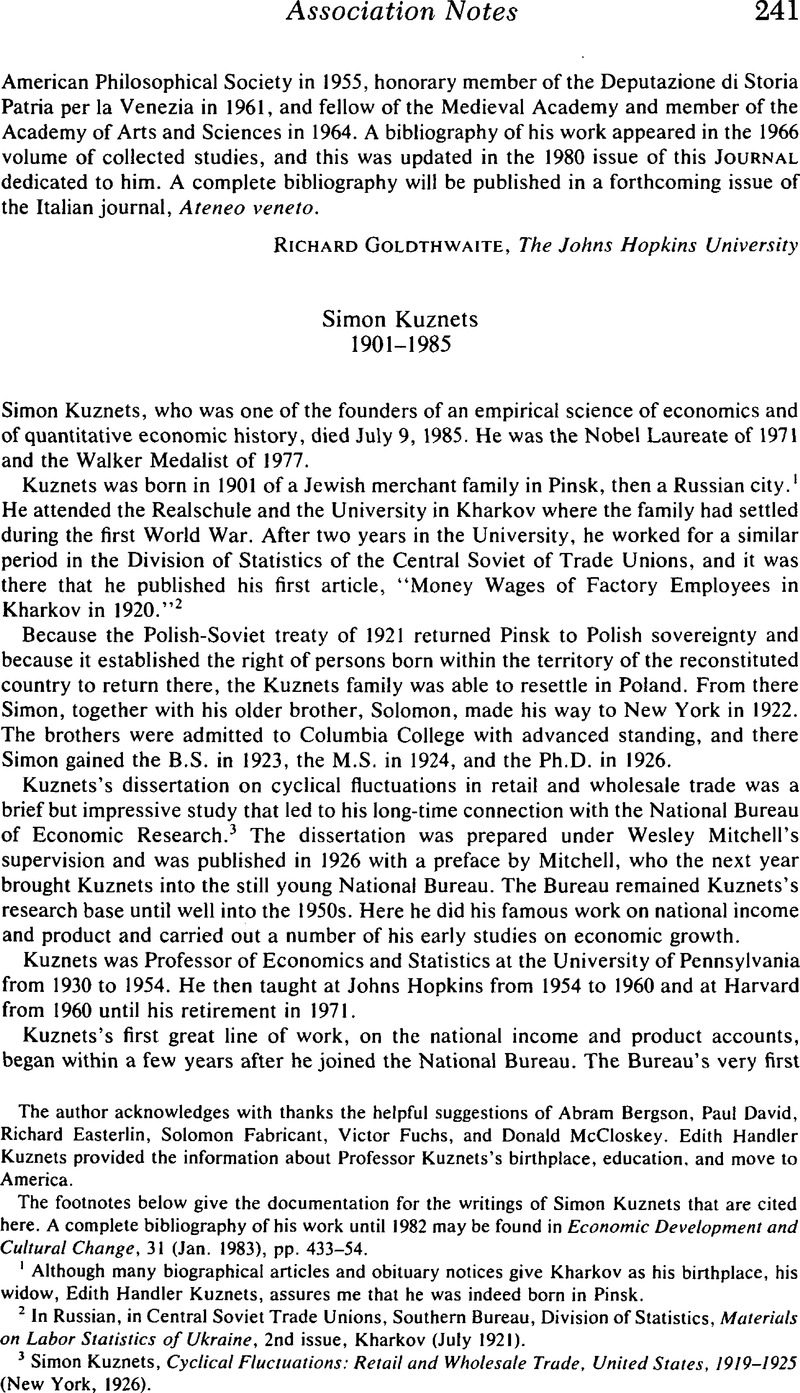Article contents
Simon Kuznets 1901–1985
Published online by Cambridge University Press: 03 March 2009
Abstract

- Type
- Association Notes
- Information
- Copyright
- Copyright © The Economic History Association 1986
References
2 Although many biographical articles and obituary notices give Kharkov as his birthplace, his widow, Edith Handler Kuznets, assures me that he was indeed born in Pinsk.
2 In Russian, in Central Soviet Trade Unions, Southern Bureau, Division of Statistics, Materials on Labor Statistics of Ukraine, 2nd issue, Kharkov (July 1921).Google Scholar
3 Kuznets, Simon, Cyclical Fluctuations: Retail and Wholesale Trade, United States, 1919–1925 (New York, 1926).Google Scholar
4 Mitchell, W. C., King, W. I., Macauley, F. R., and Knauth, O. W., Income in the United States, vol. 1:Google ScholarSummary, vol. 2: Details (New York, 1921 and 1922);Google Scholar and King, W. I., The National Income and its Purchasing Power (New York, 1930).Google Scholar
5 National Income, 1929–1932, Senate documents no. 124, 73rd Cong., 2nd sess. (Washington, D.C., 1934), p. xi.Google Scholar
6 For example, “International Differences in Income Levels: Reflections on Their Causes,” in Economic Change (New York, 1953);Google Scholar nd “Developed and Undeveloped Countries: Some Problems of Comparative Analysis,” in Zeitschrift für die Gesamte Staatswissenschaft, 124 (1968), pp. 96–107.Google Scholar
7 Kuznets, Simon, National Income and Capital Formation, 1919–1935 (New York, 1937),Google Scholar and Commodity Flow and Capital Formation (New York, 1938).Google Scholar he estimates of investment expenditures which Keynes reproduced in the General Theory were from an earlier report by Kuznets, , “Gross Capital Formation, 1919–1933,” National Bureau of Economic Research Bulletin, 52 (11 1934).Google Scholar
8 Kuznets, Simon (assisted by Epstein, Lillian and Jenks, Elizabeth), National Income and Its Composition, 1919–1938, 2 vols. (New York, 1941).Google Scholar
9 Kuznets, Simon, Shares of Upper Income Groups in Income and Savings (New York, 1953).Google Scholar
10 Kuznets, Simon, “Economic Growth and Income Inequality,” American Economic Review, 45, no. 1 (1953), pp. 1–28;Google Scholar“Quantitative Aspects of the Economic Growth of Nations: VIII, Distribution of Income by Size,” Economic Development and Cultural Change, 11, no. 2 (1963), pp. 1–80.CrossRefGoogle Scholar
11 Bacha, Edmar L., “The Kuznets Curve and Beyond: Growth and Changes in Inequalities,” in Malinvaud, Edmond, ed., Economic Growth and Resources, Proceedings of the Fifth World Congress of the International Economic Association (London, 1979), vol. 1, pp. 52–73.Google ScholarWilliamson, Jeffrey G. and Lindert, Peter H., American Inequality (New York, 1980),Google Scholar nd “Reinterpreting Britain's Social Tables, 1688–1913,” Explorations in Economic History (Jan. 1983).Google Scholar
12 Conference on Research in Income and Wealth, Trends in the American Economy in the Nineteenth Century, Studies in Income and Wealth, vol. 24 (Princeton, 1960);Google ScholarBrady, Dorothy S., ed., Output, Employment, and Productivity after 1800, Studies in Income and Wealth, vol. 30 (New York, 1966).Google Scholar
13 Kuznets, Simon, Secular Movements in Production and Prices: Their Nature and Their Bearing upon Cyclical Fluctuations (Boston, 1930).Google Scholar
14 See in particular “Long Swings in the Growth of Population and in Related Economic Variables,” Proceedings of the American Philosophical Society, 102 (1958), pp. 25–52.Google Scholar reprinted in Economic Growth and Structure: Selected Essays (New York, 1965),Google Scholar and (assisted by Jenks, Elizabeth) Capital in the American Economy: Its Formation and Financing (Princeton, 1961), chaps. 7, 8.Google Scholar
15 A typical paper is “Toward a Theory of Economic Growth,” in Lekachman, Robert, ed., National Policy for Economic Welfare at Home and Abroad (Garden City, N.Y., 1955), pp. 12–77.Google Scholar
16 Kuznets, Simon (assisted by Epstein, Lillian and Jenks, Elizabeth), National Product Since 1869 (New York, 1946),Google Scholar and “Long Term Changes in the National Income of the United States of America Since 1890,” in Income and Wealth of the United States: Trends and Structure, Income and Wealth, Series 2 (Cambridge, 1952).Google Scholar
17 Kuznets, Simon, “Quantitative Aspects of the Economic Growth of Nations,” Papers 1–10, in Economic Development and Cultural Change (1956–1965), and Modern Economic Growth: Rate, Structure and Spread (New Haven, 1966).Google Scholar
18 Kuznets, Simon, Capital in the American Economy, chap. 3.Google Scholar
19 Kuznets, Modern Economic Growth, chap. 3.Google Scholar
20 Ibid.;Google ScholarKuznets, Simon, “Modern Economic Growth: Findings and Reflections,” Nobel Memorial Lecture, Dec. 1971, in Les Prix Nobel en 1971 (Stockholm, 1972),Google Scholar reprinted in American Economic Review, 63 (1973), pp. 247–58;Google Scholar and Kuznets, Simon, “Driving Forces of Economic Growth: What Can We Learn from History?” in Weltwirtschaftliches Archiv, 116 (1981), pp. 409– 31,CrossRefGoogle Scholar and in Giersch, Herbert, ed., Towards an Explanation of Economic Growth (Tubingen, 1981).Google Scholar
21 Kuznets, Modern Economic Growth, p. 9.Google Scholar
22 Ibid., p. 12.Google Scholar
23 Ibid.
- 19
- Cited by


